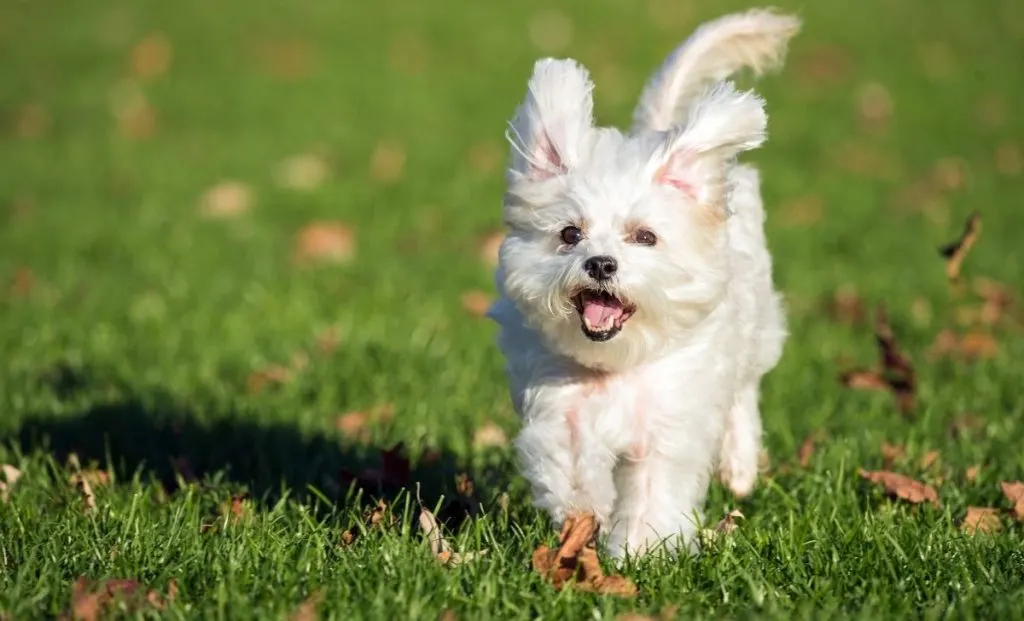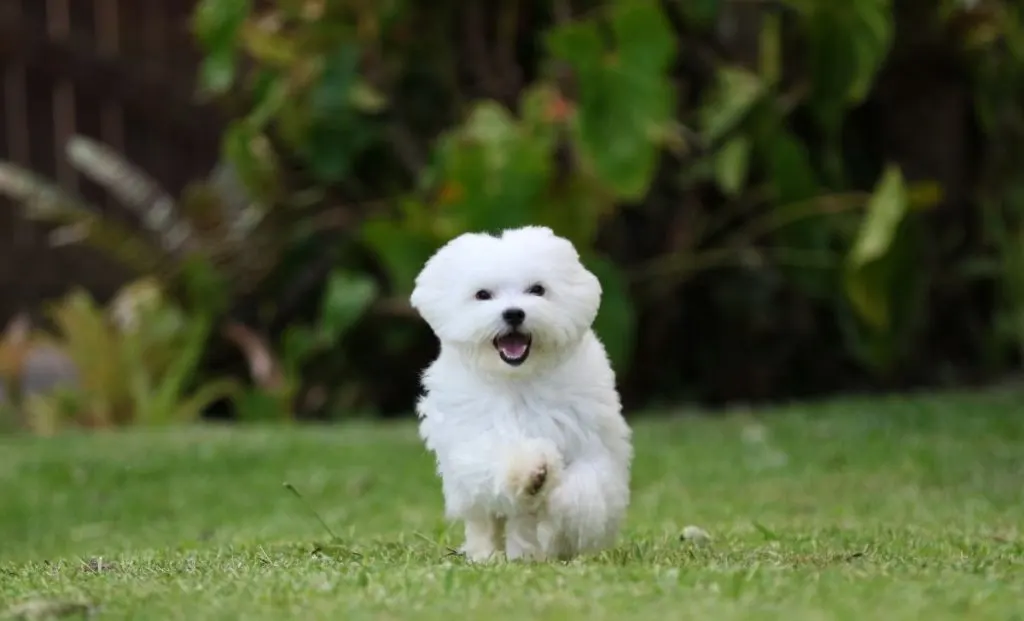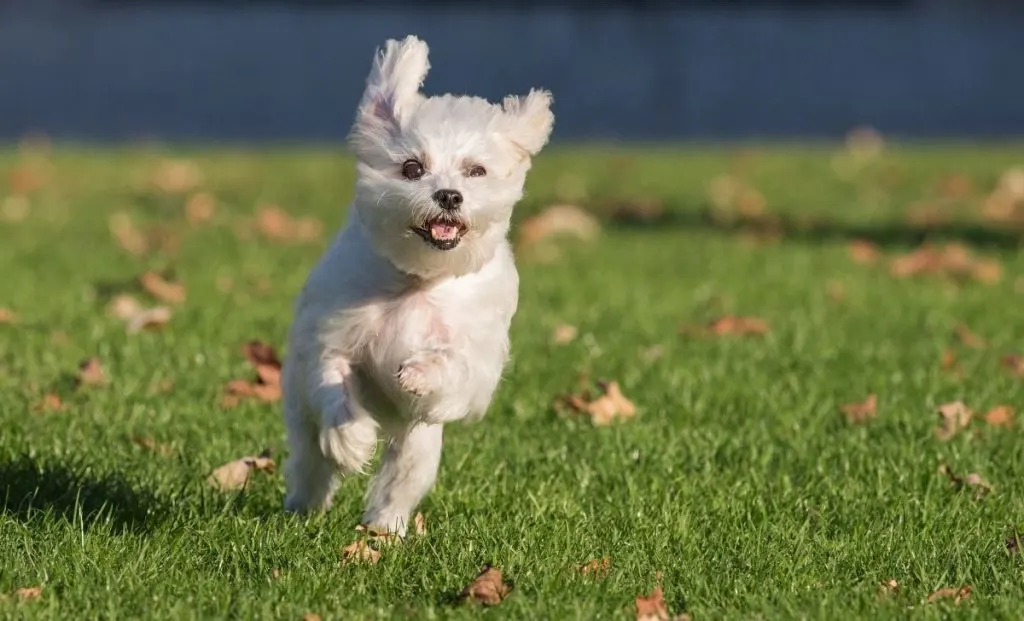Hi there! If you’re here, it’s likely because you’re either a proud Maltese owner or you’re about to become one.
Welcome to the wonderful world of Maltese dogs; these little beauties are sure to bring joy to your life.
Today, I want to focus on how these little beauties grow.
So, I am here to show you the ultimate Maltese growth chart, address some common questions, and provide extra tips and tricks to help them grow into well-rounded adult dogs.
One paw at a time!
Maltese Growth Chart Overview

Here’s a handy Maltese growth chart in pounds and kgs to give you an idea of what to expect as your puppy grows.
The following chart provides a good indication of the expected measurements for your Maltese at various months of age.
This can help you ensure your puppy is growing healthily and reaching their ideal weight and height.
| Age (Months) | Male Weight | Male Height | Female Weight | Female Height |
| lbs | kg | inch | cm | |
| 1 | 1.0 – 1.5 | 0.45 – 0.68 | 3 – 4 | 7.6 – 10.2 |
| 2 | 1.5 – 2.0 | 0.68 – 0.91 | 4 – 5 | 10.2 – 12.7 |
| 3 | 2.0 – 3.0 | 0.91 – 1.36 | 5 – 6 | 12.7 – 15.2 |
| 4 | 3.0 – 4.0 | 1.36 – 1.81 | 6 – 7 | 15.2 – 17.8 |
| 5 | 4.0 – 5.0 | 1.81 – 2.27 | 7 – 8 | 17.8 – 20.3 |
| 6 | 5.0 – 6.0 | 2.27 – 2.72 | 8 – 9 | 20.3 – 22.9 |
| 12 | 6.0 – 7.0 | 2.72 – 3.18 | 9 – 10 | 22.9 – 25.4 |
Keep in mind that these numbers are approximate and that this chart is a rough estimate. Individual dogs may vary!
As your Maltese reaches their full size, their final weight and adult height will become more apparent.
There are also great Maltese growth chart calculators available online that you can use for more precise tracking.
Yep, growth charts have been developed to monitor body weight in dogs of different sizes, including small breeds like the Maltese.
Research shows that these charts help in assessing whether a dog is growing at an optimal rate (1).
Maltese Puppy Growth Chart
If you’re like me, you’ve probably fallen head over heels for your adorable Maltese puppy. These little bundles of joy are starting their journey in life, and it’s so exciting to watch them grow.
Let’s dive into what you can expect during the first couple of weeks with your new furry friend.
Birth To 2 Weeks

During the first two weeks of life, Maltese puppies are incredibly tiny and fragile. Their birth weight typically ranges between 3 to 4 ounces (85 to 113 grams).
At this stage, they are entirely dependent on their mother for warmth, nutrition, and care. They cannot see or hear yet, as their eyes and ears are closed.
The Maltese need their momma, and they will be nursing frequently.
Sometimes, labor difficulties and other reasons can cause stressed mother dogs to eat their puppies.
So, it’s crucial that the mother is healthy and producing enough milk. After all, that is all what the puppy’s diet consists of, for now!
Even though they can’t see or hear yet, their little bodies are working hard. You may notice larger pups in the litter, and those might be boys. But we have to wait and see a bit how they continue to grow!
Their senses are developing, and soon enough, they’ll start responding to the world around them.
Expect rapid weight gain and a big push by the end of the first week! These little pups should double their birth weight. It’s a great indicator that everything is going smoothly.
2 To 4 Weeks
Fast forward to the 2 to 4-week period, and you’ll notice your Maltese puppy starting to change and grow in the most adorable ways. This phase is full of milestones and is thrilling to watch!
While they’re still nursing, you might notice the mother beginning to wean them a bit. As new pet parents, you might start thinking about how much dog food your puppy will need soon.
Here’s where things get really cute. Their eyes and ears start to open, allowing them to see and hear the world around them.
They’ll start to stand and walk, albeit a bit wobbly at first. This is the perfect time to capture those adorable first moments on video!
The best way to understand their progress is to show you the following table:
| Age (Weeks) | Weight (oz/g) | Growth Milestones |
| 2 | 10 – 12 oz / 280 – 340 g | Eyes begin to open, slight movement |
| 3 | 12 – 14 oz / 340 – 400 g | Ears begin to open, more movement |
| 4 | 14 – 16 oz / 400 – 450 g | Starts to walk, responds to sounds |
By the end of this stage, your puppy may weigh between 10 to 16 ounces (280 to 450 grams).
These little guys are growing quickly and steadily. Watching their paw size increase is a delightful indication of their future adult weight and height.
1 To 3 Months

As your Maltese puppy transitions from the early weeks into the 1 to 3 months stage, you’ll witness some of the most exciting developments.
This period is crucial for their growth and socialization, setting the foundation for a happy, healthy life. Trust me, this is where the fun really begins!
Around this time, your puppy will start transitioning from mother’s milk to solid food. It’s important to know how much dog food to give them.
Typically, you’ll begin with small amounts of high-quality puppy food, gradually increasing the quantity as they grow.
This stage is essential for establishing a balanced puppy’s diet that will support their rapid growth. Watching them eagerly gobble up their food is just too cute!
Your puppy will become more active and curious, exploring their surroundings with boundless enthusiasm. This is the ideal time to start additional training and socialization.
At this stage, they’ll develop their unique personality traits. Regular playtime and interaction are crucial, as they play a large role in their emotional and physical development.
As they grow, their fluffy fur and round faces make them look like adorable teddy bears. So, get ready for a lot of “aww” moments!
By the end of three months, your Maltese puppy will have grown significantly. They may weigh between 1.5 to 3 pounds (0.68 to 1.36 kg).
Keeping track of their weight using a Maltese weight chart can provide a good indication of whether they’re on the right track.
Regular veterinary visits are vital during this period. Your veterinarian will monitor their growth and administer necessary vaccinations.
3 To 6 Months

At the 3 to 6 months stage, your Maltese puppy is in full swing of puppyhood, and their growth and development are fascinating to watch.
This period is packed with adventures and learning as your little one continues to grow both physically and mentally.
So, how big is a 3-month-old Maltese puppy?
Between 3 to 6 months, your puppy will gain weight steadily, with their normal weight usually between 3 to 5 pounds (1.36 to 2.27 kg).
By now, your Maltese puppy should be fully transitioned to solid food. You might find yourself frequently adjusting how much dog food you give them as they grow.
It’s still vital to maintain a balanced puppy’s diet to support their rapid development.
At this stage, their nutritional needs are significant, so feeding high-quality puppy food is the way to go.
Your Maltese puppy will become more coordinated and energetic, turning every moment into an opportunity for exploration. But that doesn’t mean you shouldnt continue with training and socialization!
Their personality will blossom, and you’ll notice their unique quirks and traits. And remember that playtime is not only fun but also plays a large role in their emotional and physical development.
Regular veterinary visits continue to be crucial. Although this aristocratic dog breed is quite a healthy one, a lot can go wrong in this curious period. You naive pup may eat a bee, swallow part of a toy, or get a scratch while playing.
Apart from that, they might get tummy issues which can cause eating problems.
Monitoring your puppy’s growth and health can help catch any potential health issues early on. Also, understanding Maltese veterinary costs and planning for them is important to avoid surprises.
6 To 12 Months

This stage is critical as your little one transitions from puppyhood to adolescence, with all the ups and downs that come with it.
By six months, those sharp little puppy teeth should be gone, replaced by a full set of adult teeth. This marks the end of the teething phase, so it’s a good time to focus on dental care.
Regular brushing and providing appropriate chew toys will help maintain their dental health and keep those pearly whites shining.
It’s important to maintain this high-quality diet until they reach about 10 months old, then gradually switch to adult food designed for small breeds. Trust me, making sure they get the right nutrition is vital for their ongoing development.
During these months, you’ll notice your Maltese’s growth slowing down, but they’re still reaching milestones. Typically, there will be different weights between males and females.
For example, the larger title goes to the male Maltese, who now weighs between 4 and 7 pounds and stands about 8 to 10 inches tall. On the flip side, females tend to be slightly smaller, weighing 4 to 6 pounds and standing 7 to 9 inches tall.
Well, no matter the gender, let’s all agree that it’s fascinating to see their final weight and height come into shape, with their fluffy fur making them too cute to resist!
On that note, Maltese puppies often have a beautiful pure white coat, though some may have light lemon or tan markings on their ears.
At What Age Is A Maltese Full Grown?

Maltese puppies typically reach their full-grown size by around 8 months of age. By this time, they’ve usually hit their maximum height and most of their adult weight.
But wait, there’s a bit more to the story. If you’ve got one of the Maltese mixes, things can get a bit more interesting. These adorable designer breeds can have different growth patterns and sizes, depending on their mixed heritage.
As for purebred dogs, the growth rate, their adult height and weight are according to the official breed standards.
Some Maltese might continue to gain a little weight, mostly muscle, until they’re about 10 to 12 months old.
So, if your pup is looking a bit more robust at a year old, that’s totally normal.
Adult male Maltese generally stand about 8 to 10 inches tall, while females are a bit shorter, at 7 to 9 inches.
Both male and female Maltese usually weigh between 4 to 7 pounds, with most of this growth happening by the time they’re 8 months old.
In those first few months, your Maltese will grow like a weed, gaining about one pound a month from ages 2 to 8 months. After that, the growth spurt slows down significantly.
An interesting study on body-weight changes during growth highlighted that small breeds like Maltese dogs reach their adult body weight faster compared to larger breeds.
Accurate feeding guides are crucial to prevent overnutrition, which can lead to obesity and other health issues (2).
At What Age Does A Maltese Calm Down?

When it comes to your purebred Maltese, those first few years are a whirlwind of energy and excitement. You might find yourself asking, “When will my little furball finally calm down?”
Well, the good news is that there’s a light at the end of the tunnel.
Generally, Maltese puppies start to show signs of calming down around 3 to 4 years of age.
Up until this point, these little bundles of joy are full of boundless energy, always eager to explore, play, and, yes, chase that favorite squeaky toy around the house.
Maltese Puppyhood Help And 5 Tips For Pet Parents

Raising pups is hard, I know!
But don’t worry, I’ve got your back. Here’s a guide packed with useful tips to add to your new puppy checklist.
Let’s go through the adorable chaos of Maltese puppyhood together!
1. Nutrition Matters
First things first, let’s talk food. Your little fluff ball needs high-quality puppy food designed for small breeds.
Stick to puppy food until they are about 10 months old, then transition to adult food. And remember, portion control is key.
Use a standard measuring cup to avoid overfeeding. Your Maltese might beg for more, but those puppy eyes are masters of deception!
Pro Tip: Treats are okay, but keep them in moderation. Too many treats can lead to a pudgy pup, and we want them to stay healthy and fit.
2. Regular Exercise And Play
Maltese puppies are bundles of energy and need regular exercise to burn off that exuberance.
Daily walks, play sessions, and interactive toys are a must. Not only does this keep them physically fit, but it also helps with mental stimulation.
But hey, don’t overdo it! Exercise is good, but these little dogs can get tired easily.
3. Consistent Training
Start training your Maltese as soon as they come home.
They are smart and eager to learn, especially when there are treats involved.
Focus on basic commands like sit, stay, come, and down. Use positive reinforcement techniques with lots of praise and treats.
Don’t be surprised if some Maltese are a bit stubborn. They might have a few accidents or ignore commands initially, but with consistent effort, they’ll catch on.
And remember that short, consistent training sessions are more effective than long, infrequent ones!
4. Socialization Is A Must
Introduce your Maltese to various environments, people, and other animals early on. This helps them become well-rounded and reduces the risk of behavioral issues.
Puppy classes are a fantastic way to socialize them in a controlled setting.
In fact, structured socialization classes provided by veterinarians or training centers enhance social skills and obedience, benefiting both the dog and the owner (3).
Take them on car rides, visits to friends’ houses, and walks in different parks. Their small size makes these outings a thrill!
The more experiences they have, the more adaptable they’ll be!
5. Regular Veterinary Check-ups
Undoubtedly, Maltese dogs are among the most beautiful breeds. However, maintaining their beauty goes hand in hand with ensuring they stay healthy.
Your vet is your best friend when it comes to your puppy’s health. Regular contact with your vet and regular check-ups are important for you to catch potential health issues early.
Keep up with vaccinations, deworming, and flea prevention.
Schedule regular appointments and follow your vet’s advice on vaccination schedules and overall care.
Can Maltese Live Up To 20 Years?
Yes, Maltese dogs can live up to 20 years! While it’s not the average lifespan, it’s definitely possible with the right care and a bit of luck.
One of the great things about small dog breeds, like the Maltese, is that they tend to live longer than their larger counterparts. While big dogs often have shorter lifespans, small dogs generally enjoy more years.
For the Maltese, the average lifespan is around 12 to 15 years, but many live well into their late teens. With excellent care, some even reach that impressive 20-year milestone.
Watching your pup grow is such a delightful experience, and keeping an eye on the Maltese growth chart can help ensure they’re developing healthily.
As a key takeaway – Maltese get to be an aristocratic dog breed, weighing between 4 to 7 pounds when they’re fully grown, although some can be of a larger size.
Regular check-ups, a balanced puppy’s diet, and lots of love will help your pup grow into a happy, healthy adult.
After all, the end goal is to see your Maltese reach their ideal weight and adult height, living a joyful and vibrant life!
Enjoy every moment with your little Maltese beauty and keep this growth chart handy.
References
1. Salt, C., Morris, P., German, A., Wilson, D., Lund, E., Cole, T., & Butterwick, R. (2017). Growth standard charts for monitoring bodyweight in dogs of different sizes. PLoS ONE, 12. https://doi.org/10.1371/journal.pone.0182064.
2. Hawthorne, A., Booles, D., Nugent, P., Gettinby, G., & Wilkinson, J. (2004). Body-weight changes during growth in puppies of different breeds.. The Journal of nutrition, 134 8 Suppl, 2027S-2030S . https://doi.org/10.1093/jn/134.8.2027S.
3. Seksel, K. (1997). Puppy socialization classes.. The Veterinary clinics of North America. Small animal practice, 27 3, 465-77 . https://doi.org/10.1016/S0195-5616(97)50049-0.

Meet Iram, a devoted veterinarian, passionate dog lover, and current Ph.D. candidate at Utrecht University in the Netherlands. Seamlessly blending her roles as a vet and content writer, Iram channels her love for dogs into heartfelt narratives.
Since childhood, Iram nurtured a dream of becoming a vet, a passion that runs deep in her family. Having now fulfilled that dream, she’s eager to share her acquired knowledge. In her writing, Iram not only explores the emotional bond between humans and their canine friends but also integrates her veterinary expertise, offering readers a holistic understanding of their beloved pets.
